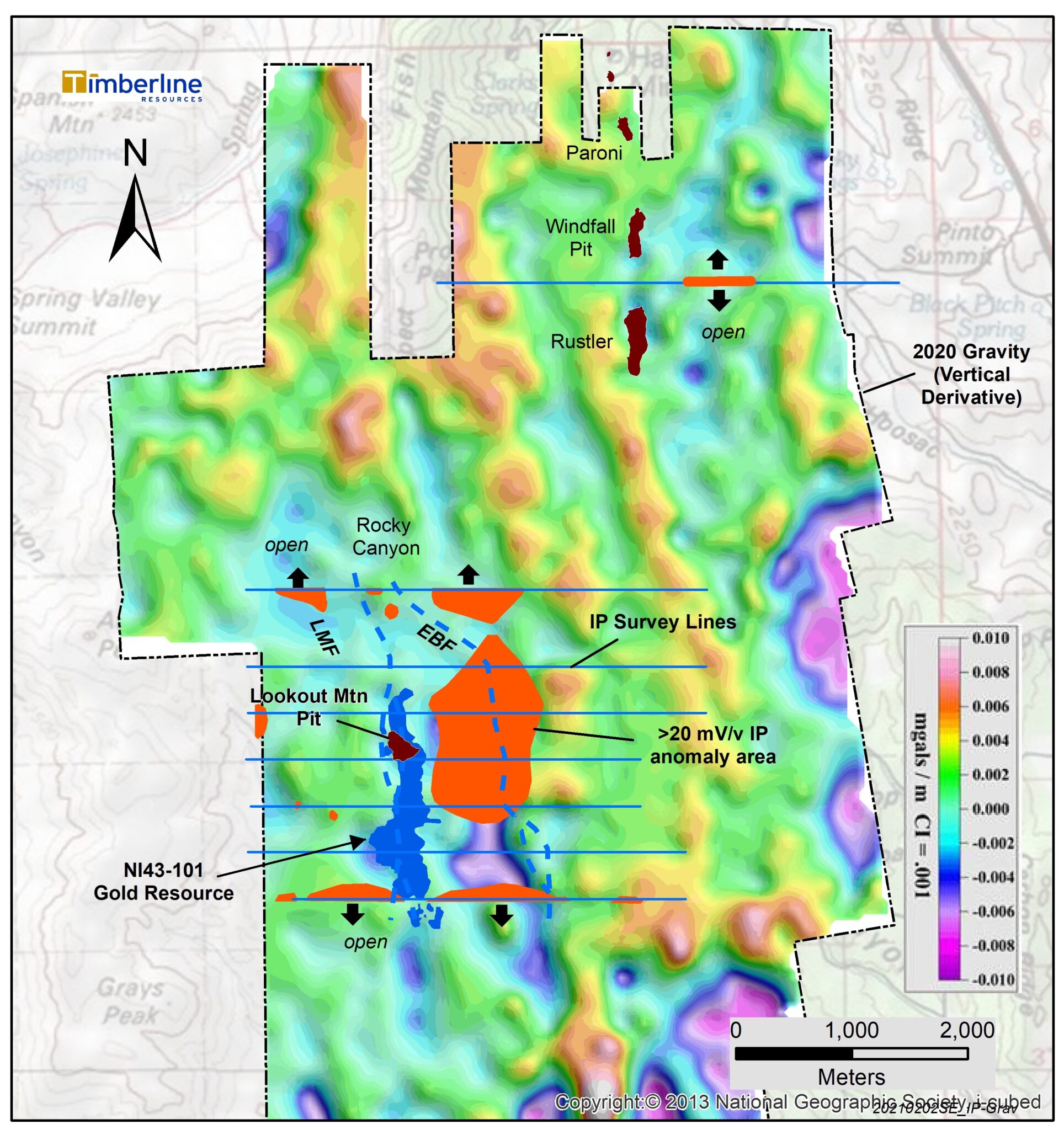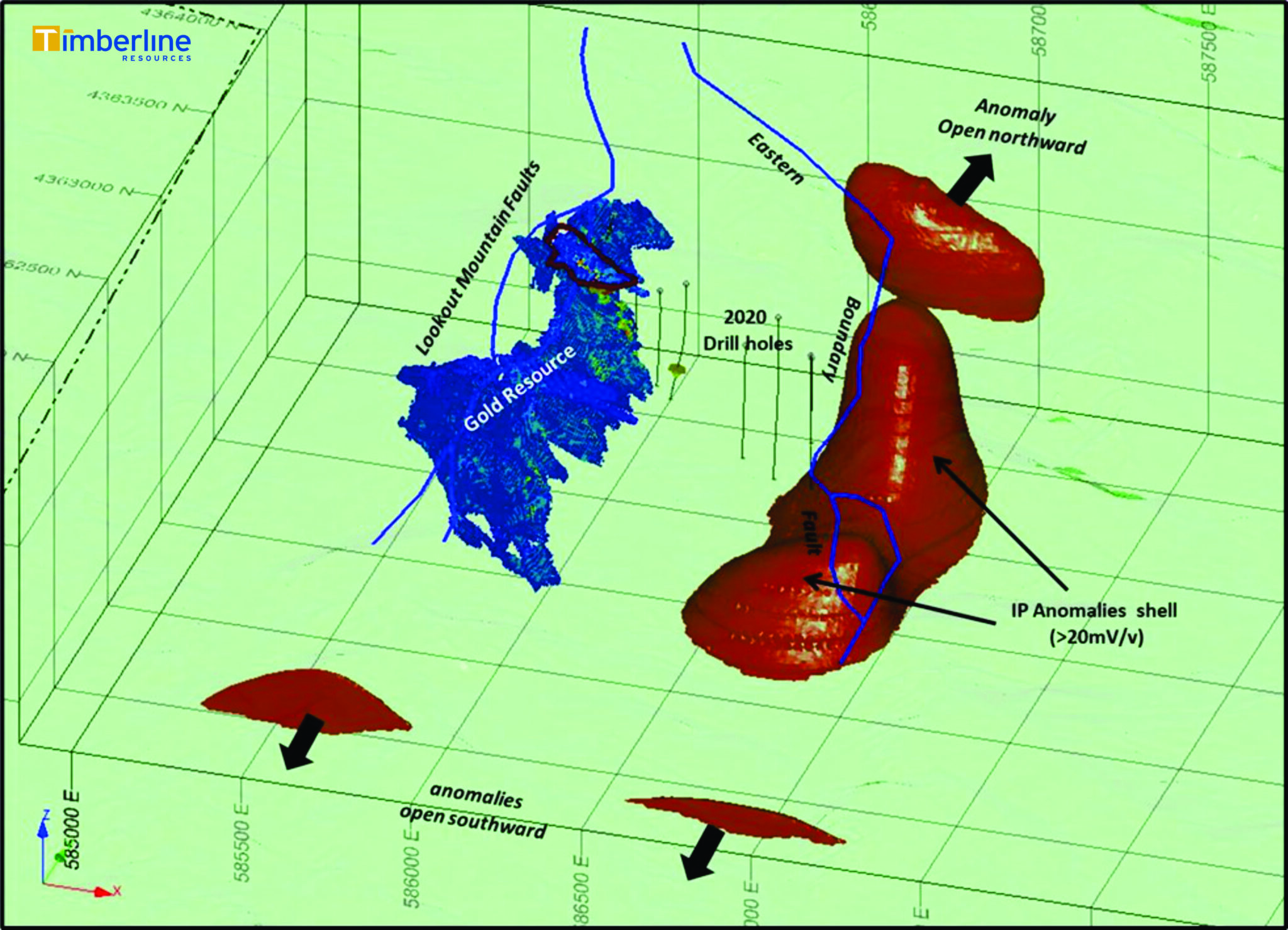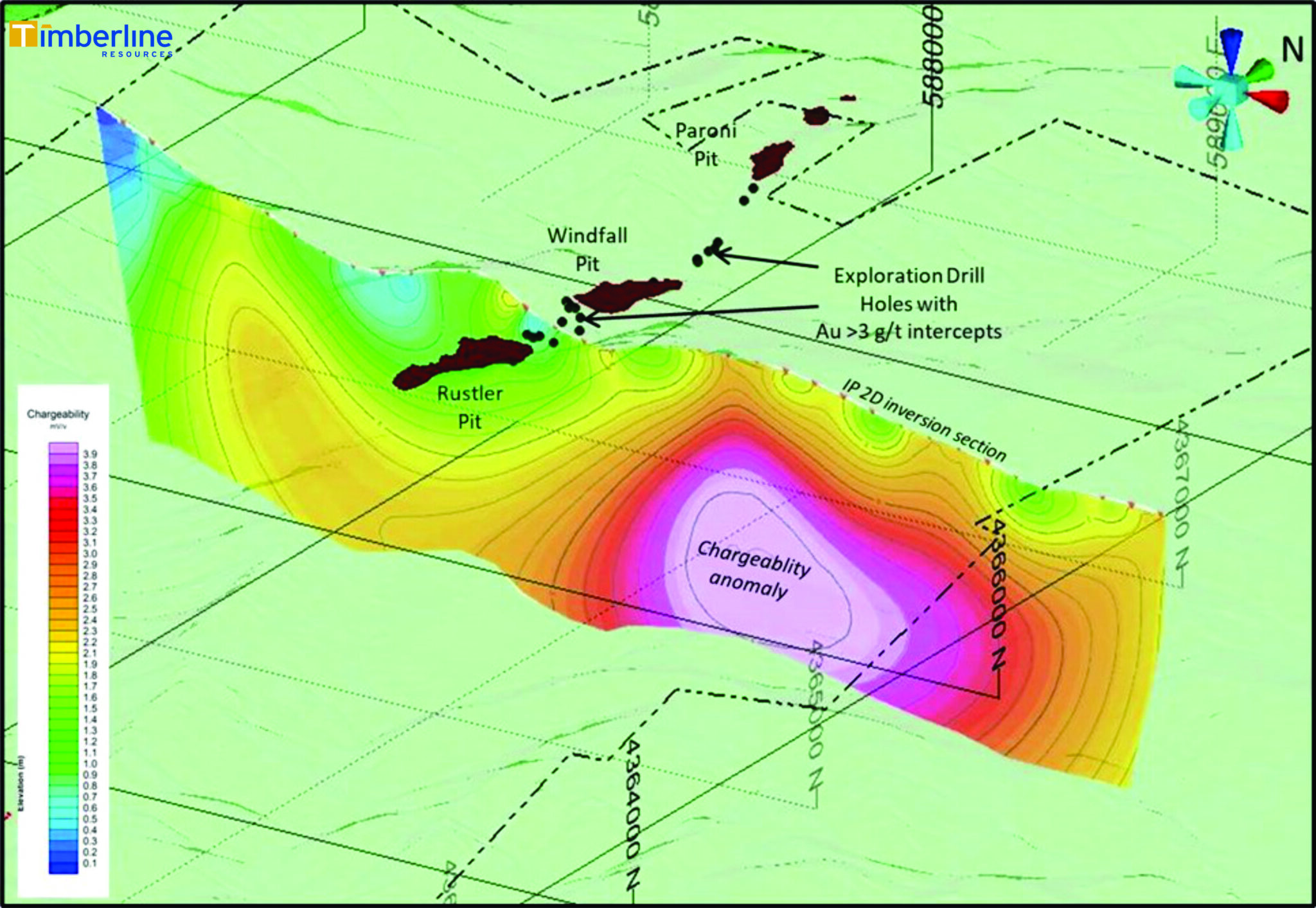Coeur d’Alene, Idaho – February 3, 2021 – Timberline Resources Corporation (OTCQB: TLRS; TSX-V: TBR) (“Timberline” or the “Company”) today announced results of an Induced Polarization – Resistivity (IP) geophysical survey (Figure 1) at its 100%-controlled Eureka Project in Nevada. The IP survey included 28.4 line-kilometers over eight lines, focused primarily at the Lookout Mountain Target. IP can be an effective tool for mapping subsurface electrical characteristics of the rocks related to the distribution of sulfide minerals and organic carbon, which are often associated with Carlin-type gold deposits. IP surveys may also help map fault structures that are related to or crosscut mineralization.
Highlights of the IP survey at Eureka include:
- A strong chargeability anomaly spanning at least two kilometers in a north-south direction east of the Lookout Mountain gold resource and east of the Rocky Canyon Zone (Figure 1);
- Identified two major fault zones: the Lookout Mountain Fault (LMF) which is associated with known gold mineralization, and the East Bounding Fault (EBF) which is undrilled; and
- A moderate chargeability anomaly occurs on the test line at the Windfall Target that has a similar morphology and relationship to known gold mineralization as the anomaly at the Lookout Zone.
Timberline also previously reported a district-scale gravity survey at Eureka (see Company news release dated Nov 2, 2020 at https://timberlineresources.co/press-releases). These two large-scale geophysical surveys are complementary, and Timberline is developing a fully integrated interpretation of these data with the growing geological database, which includes drilling, mapping, surface sampling, and modeling.
Patrick Highsmith, Timberline’s President and CEO commented, “The 2020 IP survey at the Eureka Project suggests a much larger footprint to the mineral system than is evident from drilling to date. Our integrated interpretation of the IP and gravity surveys in concert with our improved understanding of the geology has highlighted many new targets at Eureka. Our initial focus in 2021 will be to link the recently announced high-grade step-out drill intercepts with the main body of the Lookout Mountain resource.”
IP Survey Details and Discussion
Simcoe Geoscience Ltd. of Toronto, Ontario (“Simcoe”) completed the time-domain IP survey using the dipole-dipole method along eight lines totalling 28.4 line kilometers (Figure 1), generally spaced 400 meters apart. The survey configuration (200-meter dipole separation) resulted in an estimated depth of resolution of more than 600 meters. The majority of the survey was conducted at the Lookout Mountain Target, where it was designed to cover the main body of known gold mineralization and extend eastward across a graben structure.
The IP data was processed by Simcoe with an independent review by Wright Geophysics. The geophysicists prepared a 2D inversion of the data on each line to produce cross-sections of resistivity and chargeability contours. The 2D cross-sections are integrated into 3D models representing the chargeability and resistivity data. A 3D perspective view of the chargeability model and Lookout Mountain block model shows an intense chargeability anomaly (≥20 mV/v) at depth and approximately 500 meters east of the known gold resource (Figure 2).
Figure 1. Eureka Project IP Survey and Anomalies over Gravity Vertical Derivative Base Map

The model shows that the newly defined IP anomaly is associated with a major fault (EBF) and has a complex shape. A saddle separates two lobes that rise closer to surface, the northern of which comes to within approximately 150 meters of surface. A separate anomaly occurs farther north in the Rocky Canyon area. The 2020 core holes were drilled to the west of and in the saddle of the main IP feature and terminated above the interpreted depth of the strongest part of the anomaly. The known gold mineralization at Lookout Mountain and the higher-grade Water Well Zone is associated with the lower magnitude part of the IP response.
Figure 2. 3D View of Lookout Mountain Gold Resource and IP Anomalies with 2020 Drillholes

Historical gold mining at Windfall recovered approximately 115,000 ounces of gold from altered shale and dolomite along a major fault, a similar stratigraphic and structural setting as at Lookout Mountain. The sedimentary rocks dip east from the historical pits. Drilling by Timberline and others has intercepted relatively high-grade gold (> 3 g/t) between and beneath the pits, as well as along trend to the north and south.
The Company completed a single east-west IP test line between the Windfall and Rustler historic open pits (Figure 1). As at Lookout Mountain, a distinct chargeability anomaly occurs east of the known mineralization (Figure 3). The shape of the geophysical anomalies supports an eastward dip to the favorable rock sequence. The geophysics also suggests the presence of several faults in the Windfall area. A more extensive IP survey in the Windfall area is planned during 2021.
Figure 3. Windfall Target 3D Perspective with 2D IP Inversion Section

Steven Osterberg, Ph.D., P.G., Timberline’s Vice President Exploration, is a Qualified Person as defined by National Instrument 43-101 and has reviewed and approved the technical contents of this release. Dr. Osterberg is not independent of the Company as he is an officer and a director.
About Timberline Resources
Timberline Resources Corporation is focused on delivering high-grade Carlin-Type gold discoveries at its district-scale Eureka Project in Nevada. The Eureka Property includes the historic Lookout Mountain and Windfall mines in a total property position of approximately 24 square miles (62 square kilometers). The Lookout Mountain Resource was reported in compliance with Canadian NI 43-101 in an Updated Technical Report on the Lookout Mountain Project by Mine Development Associates, Effective March 1, 2013, filed on SEDAR April 12, 2013.
| Resource Category |
Tonnage (million short tons) |
Grade (oz/ton) |
Grade (grams/tonne) |
Contained Au (troy oz) |
| Measured | 3.04 | 0.035 | 1.2 | 106,000 |
| Indicated | 25.90 | 0.016 | 0.6 | 402,000 |
| Inferred | 11.71 | 0.012 | 0.41 | 141,000 |
The Company is also operator of the Paiute Joint Venture Project with Nevada Gold Mines in the Battle Mountain District. These properties all lie on the prolific Battle Mountain-Eureka gold trend. Timberline also controls the Seven Troughs Project in northern Nevada, which is one of the state’s highest-grade former gold producers. Timberline controls over 43 square miles (111 square kilometers) of mineral rights in Nevada. Detailed maps and mineral resources estimates for the Eureka Project and NI 43-101 technical reports for its projects may be viewed at https://timberlineresources.co/.
Timberline is listed on the OTCQB where it trades under the symbol “TLRS” and on the TSX Venture Exchange where it trades under the symbol “TBR”.
Forward-looking Statements: Statements contained herein that are not based upon current or historical fact are forward-looking in nature and constitute forward-looking statements within the meaning of Section 27A of the Securities Act of 1933 and Section 21E of the Securities Exchange Act of 1934. Such forward-looking statements reflect the Company’s expectations about its future operating results, performance and opportunities that involve substantial risks and uncertainties. These include, but are not limited to, statements regarding the advancement of projects, and exploration potential. When used herein, the words “anticipate,” “believe,” “estimate,” “upcoming,” “plan,” “target”, “intend”, “growth opportunity” and “expect” and similar expressions, as they relate to Timberline Resources Corporation, its subsidiaries, or its management, are intended to identify such forward-looking statements. These forward-looking statements are based on information currently available to the Company and are subject to a number of risks, uncertainties, and other factors that could cause the Company’s actual results, performance, prospects, and opportunities to differ materially from those expressed in, or implied by, these forward-looking statements. Factors that could cause or contribute to risks involving forward-looking statements include, but are not limited to, changes in the Company’s business and other factors, including risk factors discussed in the Company’s Form 10-K for the year ended September 30, 2020. Except as required by law, the Company does not undertake any obligation to release publicly any revisions to any forward-looking statements.
Neither the TSX Venture Exchange nor its Regulation Services Provider (as that term is defined in the policies of the TSX Venture Exchange) accept responsibility for the adequacy or accuracy of this release.
On behalf of the Board of Directors,
“Patrick Highsmith”
President and CEO
Tel: 208-664-4859
